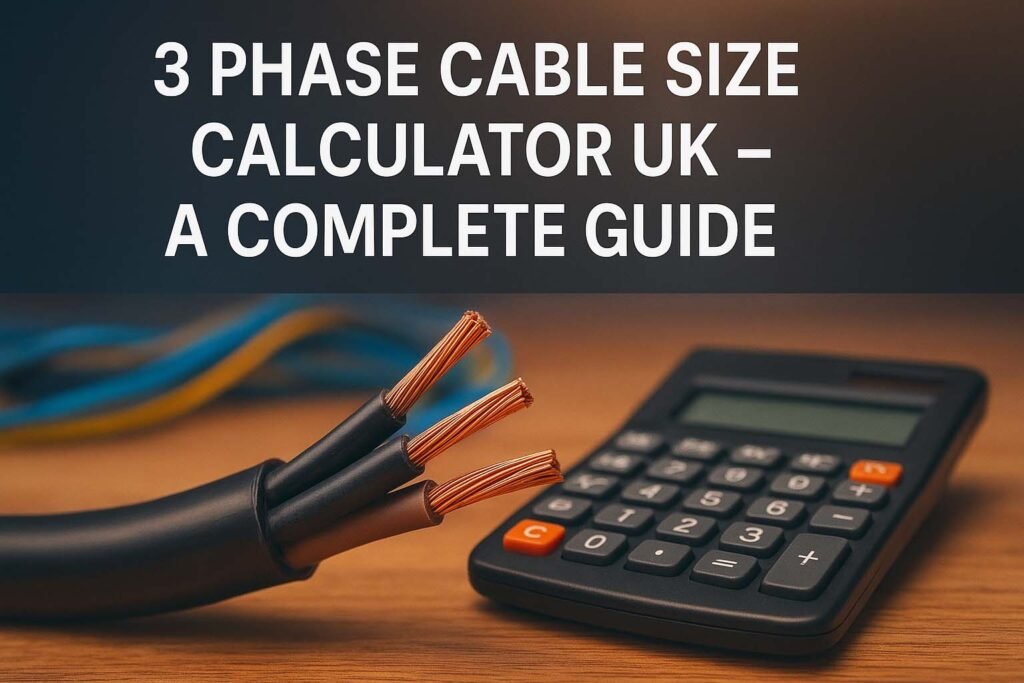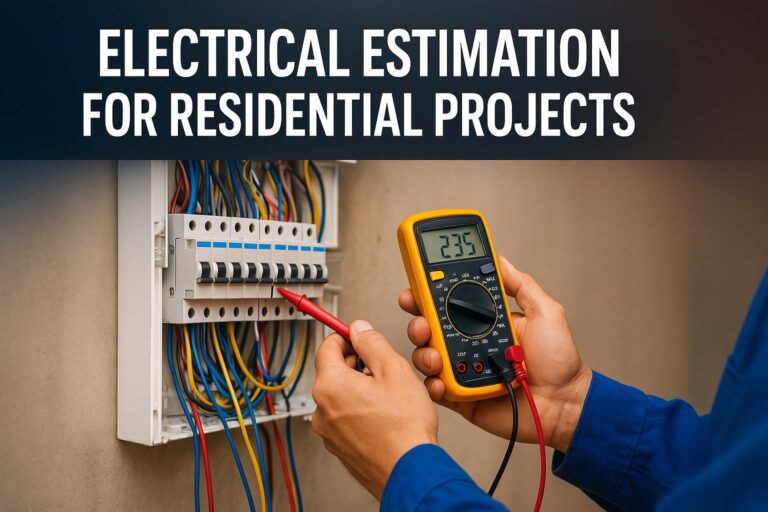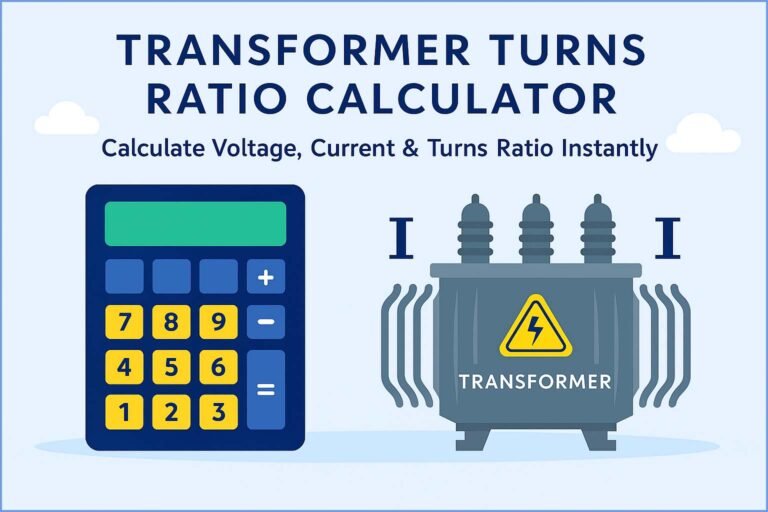3 Phase Cable Size Calculator UK – A Complete Guide
When designing or installing a 3-phase electrical system, selecting the correct cable size is one of the most critical steps. Using the wrong cable can lead to overheating, energy losses, and even fire hazards. In the UK, electrical wiring must comply with BS 7671 Wiring Regulations, which define how to size cables based on current, voltage drop, and installation method. Choosing the right conductor size requires a balance between safety, efficiency, and cost. To simplify this process, engineers and electricians often use a 3 phase cable size calculator, which makes the job accurate and much faster.
Table of Contents
Table of Contents

Cable sizing is not just about current rating. Other factors such as ambient temperature, type of insulation, installation method, and distance of the load all play a role. That is why relying only on standard tables may not always be practical. A 3 phase cable size calculator UK is designed specifically to account for these real-world conditions, ensuring compliance with UK standards and safe operation.
In this article, we will cover everything you need to know about cable sizing for three-phase systems. From understanding the basics of cable ratings to step-by-step examples, this guide will help you get it right every time. By the end, you will know exactly how to use a calculator effectively and why it is an essential tool for professionals.
Key Takeaways:
- Correct cable sizing prevents overheating, energy losses, and hazards.
- The UK follows BS 7671 standards for 3-phase cable sizing.
- A 3 phase cable size calculator UK saves time and improves accuracy.
- Factors such as load, distance, and installation method must be considered.
- Voltage drop and short-circuit capacity are just as important as ampacity.
Why Cable Sizing is Important in the UK
The electrical load in three-phase systems is often much larger than single-phase systems. Industrial motors, commercial HVAC systems, and heavy-duty machinery require higher current. If the cable is undersized, it can overheat and degrade the insulation. Over time, this may result in dangerous faults and even complete system failure. On the other hand, using a much larger cable than required increases project costs unnecessarily.
The UK has strict compliance standards to avoid such risks. According to BS 7671 (IET Wiring Regulations), all conductors must be sized to handle both normal operating current and potential fault currents. Using a 3 phase cable size calculator UK ensures you remain within safe and approved limits.
How Does a 3 Phase Cable Size Calculator UK Work?
A cable size calculator simplifies the complex mathematical process of determining cable cross-sectional area. It requires a few basic inputs, such as:
- Load power in kilowatts (kW) or kilovolt-amperes (kVA)
- System voltage (usually 400V for 3-phase in the UK)
- Power factor (commonly 0.8–1.0 depending on the load)
- Length of the run in meters
- Installation method (buried cable, clipped direct, in conduit, etc.)
- Ambient temperature
- Desired maximum voltage drop (usually 3–5%)
The calculator uses these inputs to provide the most suitable conductor size according to UK wiring regulations. This saves engineers from manually checking tables and applying multiple correction factors.
Use our online tool Circuit Breaker Size Calculator for Appliances
Formula Behind Cable Sizing
Although calculators make it simple, understanding the underlying formula is useful. For three-phase circuits, the current is calculated as:
I = P / (√3 × V × PF)
Where:
- I = Current in amperes (A)
- P = Power in watts (W) or kilowatts (kW × 1000)
- V = Line voltage (400V in most UK systems)
- PF = Power factor (decimal value)
Once the current is known, correction factors are applied for installation conditions, and then the cable cross-sectional area is chosen to handle both current and voltage drop.
Example Calculation
Suppose we have a 30 kW motor running at 400V, with a power factor of 0.85, installed 50 meters away.
Current (I) = 30,000 / (√3 × 400 × 0.85) ≈ 51A
Now we apply voltage drop limits. For a 50m run, the cable must be sized to ensure voltage drop does not exceed 5% (about 20V). A 3 phase cable size calculator UK would instantly recommend the correct cable size (likely 10mm² or 16mm² copper depending on installation method).
Factors Considered in Cable Sizing
1. Current Carrying Capacity
This is the maximum continuous current the cable can handle without exceeding its temperature rating.
2. Voltage Drop
For 3-phase systems in the UK, voltage drop should not exceed 3% for lighting circuits and 5% for other loads.
3. Short Circuit Rating
Cables must be able to withstand fault current until the protective device clears the fault.
4. Installation Method
A cable clipped to a wall has better cooling than one buried underground. This affects ampacity significantly.
5. Ambient Temperature
High temperatures reduce current-carrying capacity. Correction factors must be applied.
6. Power Factor and Load Type
Inductive loads such as motors have lower power factors, requiring slightly larger cables to reduce voltage drop.
Use our online tool Power Factor Correction Capacitor Calculator – Complete Technical Guide
Standard UK Cable Sizes for 3 Phase Loads
The following table gives approximate current ratings for copper conductors installed in standard conditions (clipped direct, 30°C ambient). Always check BS 7671 or use a 3 phase cable size calculator UK for precise values.
| Cable Size (mm²) | Approx Current Rating (A) | Typical Application |
|---|---|---|
| 2.5 mm² | 27 A | Small 3-phase loads, lighting |
| 4 mm² | 37 A | Small machinery |
| 6 mm² | 47 A | Motors, HVAC units |
| 10 mm² | 65 A | Medium loads |
| 16 mm² | 87 A | Large machinery |
| 25 mm² | 114 A | Heavy motors |
| 35 mm² | 141 A | Industrial feeders |
| 50 mm² | 176 A | Distribution cables |
| 70 mm² | 221 A | Main incomers |
These are guideline values only. Actual size depends on voltage drop and other correction factors.
Know more about IEC Standard for DC Cable Sizing – Complete Technical Guide
Voltage Drop Calculations in the UK
Voltage drop is a major consideration for 3-phase systems. In the UK, the formula for voltage drop is:
ΔV = (√3 × I × L × mV) / 1000
Where:
- ΔV = Voltage drop (V)
- I = Load current (A)
- L = Length of run (m)
- mV = Millivolt drop per ampere per meter (from tables)
For example, if we use a 10 mm² copper cable with mV = 4.4, carrying 51A over 50m:
ΔV = (1.732 × 51 × 50 × 4.4) / 1000 ≈ 19V
This is just under 5% of 400V, so the cable is acceptable.
Benefits of Using a 3 Phase Cable Size Calculator UK
- Saves time by avoiding manual calculations.
- Reduces errors in sizing.
- Ensures compliance with BS 7671.
- Optimizes cost by avoiding oversized cables.
- Provides quick results for different scenarios.
Use our online tool Watt to Amp Calculator (Single & Three-Phase)
Common Mistakes to Avoid
Many installers make mistakes that a good calculator can prevent. These include ignoring power factor, not considering installation method, underestimating distance, and forgetting voltage drop limits. By using a 3 phase cable size calculator UK, these risks are eliminated.
Practical Applications
- Industrial motor installations
- Commercial building distribution boards
- Data centers and HVAC systems
- Renewable energy systems like solar inverters
- EV charging infrastructure
Each of these applications requires careful cable selection to maintain efficiency and safety.
Why Professionals Rely on Calculators
Even though experienced electricians can size cables using tables, calculators add an extra layer of accuracy. With complex projects involving long distances and varying loads, a 3 phase cable size calculator UK ensures precision. It also allows quick comparison between copper and aluminium cables, giving cost-effective choices.
Conclusion
Choosing the right conductor size in a three-phase system is one of the most important decisions in electrical design. In the UK, strict compliance with BS 7671 Wiring Regulations makes it essential to use accurate methods. A 3 phase cable size calculator provides a quick and reliable way to determine the best cable size, avoiding the risks of undersizing or oversizing.
Use our online tool AWG to mm² Calculator – Convert Wire Sizes Easily and Accurately
By considering factors such as current, voltage drop, installation method, and fault level, electricians can ensure both safety and efficiency. Whether you are working on industrial motors, commercial systems, or renewable energy projects, using a 3 phase cable size calculator UK is the smart way forward. It saves time, reduces cost, and ensures your installation meets the highest safety standards.
Follow Us on Social:
Subscribe our Newsletter on Electrical Insights to get the latest updates in Electrical Engineering.
#3PhaseCableSizeCalculatorUK, #CableSizeCalculator, #ElectricalWiringUK, #UKElectricalStandards, #CableSizingGuide, #ElectricalEngineeringUK, #3PhasePower, #WireSizeCalculator, #ElectricalSafetyUK, #PowerDistribution, #CableCalculationUK, #UKElectricians, #WiringRegulationsUK, #ElectricalLoadCalculator, #UKPowerSystems






